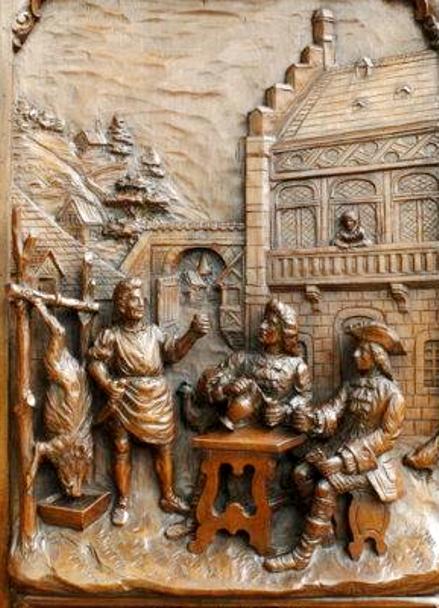
A boar roast and beer for dinner – what could be greater?
CR- CIDER JUG 11.75 IN .19th century Oak Ale or Cider Jug, coopered in brass and with turned base, ‘V Radford Maker’stamped on top brass hoop.
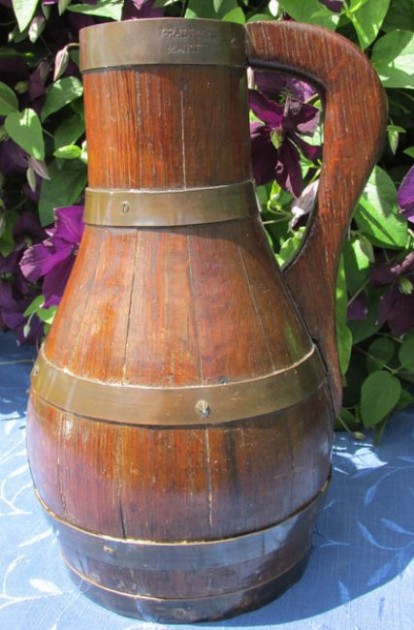
Cinque Ports Pottery – English potters,many owners made mugs, some custom ~ some retail; Examples below ▼
SEE: http://www.studiopottery.com/cgi-bin/pp.cgi?item=1593
The Monastery Rye Tankard [RAAREN STYLE] -2 EBAY 2-2015
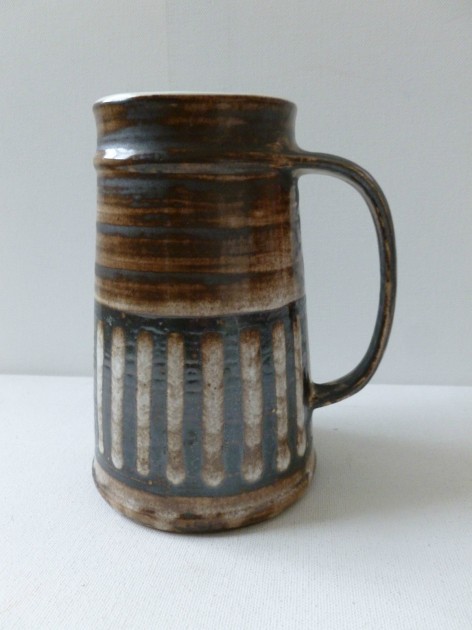
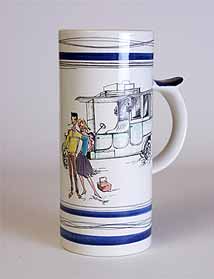
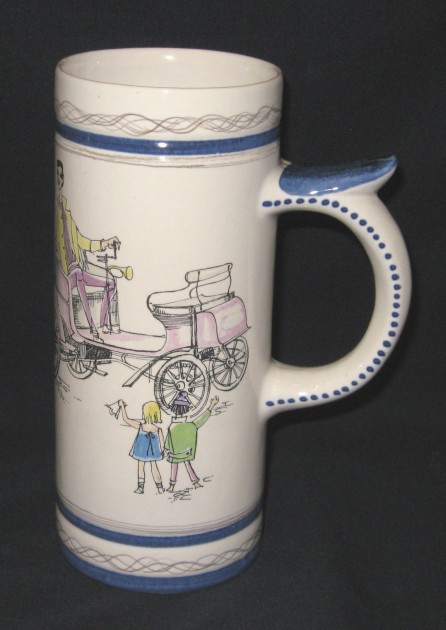
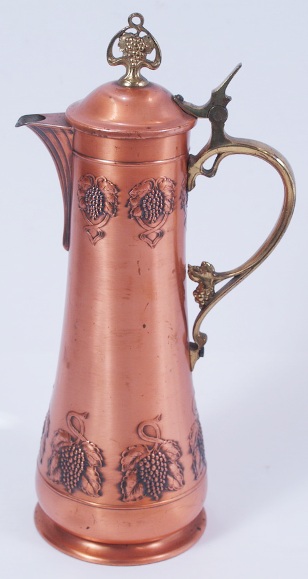
▲Claret jug – Any wine server for Claret wine (Bordeaux.) Usually tall and thin. Very popular in the early 1900’s. Shown: WMF Copper and brass Server – 13.6 In. tall. These copper and brass Arts and crafts style are numerous and I usually think they are way overpriced even WMF ones. Below ▼ is one example , because of the lEg attachments, I wouldn’t mind having in FWTD; if it wasn’t damaged, butl ” if wishes were fishes “! tHR CLARET JUS OF COPPER AND BRASS ARE A LOT MORE COLLECTABL E IN GERMNAY AND THE REST OF EUROPE THAN HERE IN THE USA.
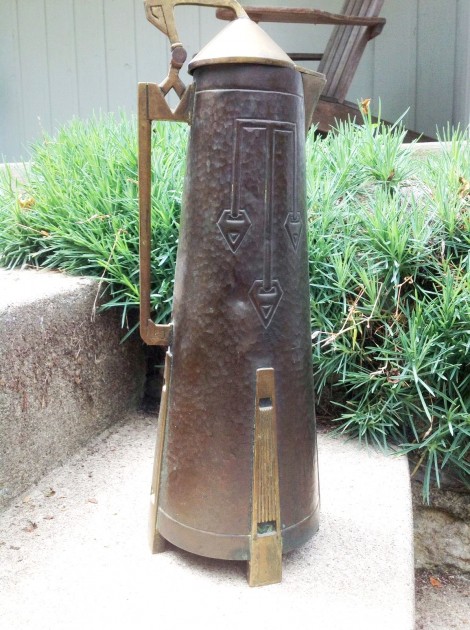
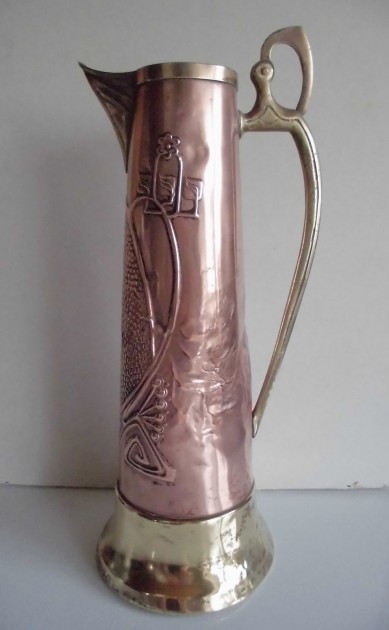
German, The Brothers Bing (Gebreuter Bing , Nurenberg, made dozens of these type jugs. . This above ▲ is an unusual unlidded one.
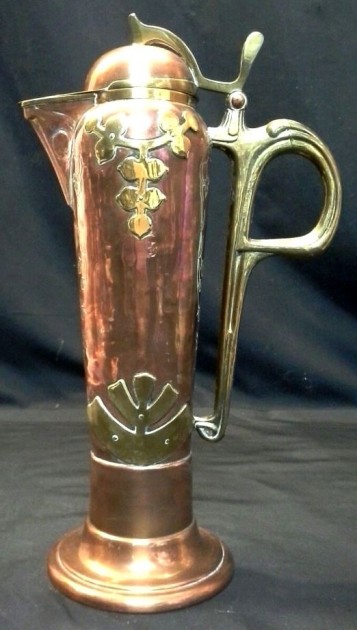
Very different in style; I liked this one and almost bought it for “From Which To Drink,” but had just bought this little carved wooden 21 inch shelf below ▼ for one of my displays.As much as some of us wish, we cant buy every nice thing out there!
![VERY EXPENSIVE CCARVED WALL SHELF IN ENG 2-2015 20 in high, shelf 16 in w [x] 9 in deep 1-27-15](http://www.steveonsteins.com/wp-content/uploads/2013/06/VERY-EXPENSIVE-CCARVED-WALL-SHELF-IN-ENG-2-2015- 20-in-high-shelf-16-in-w-x-9-in-deep-1-27-15.jpg)
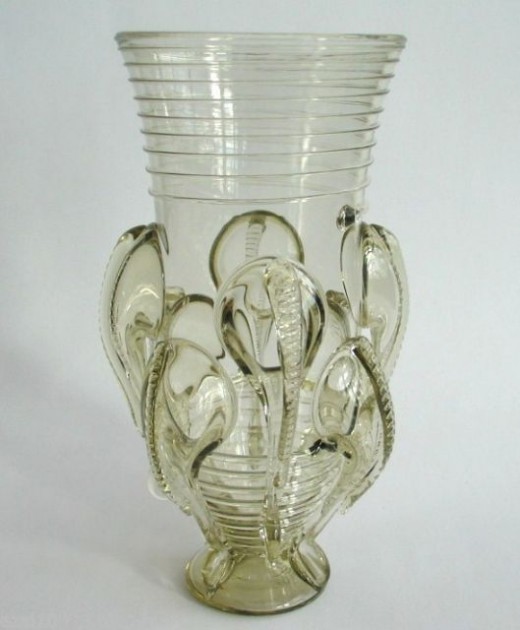
Claw beaker – Olden “Waldglass” beakers with running application of glass on the sides so the beaker wouldn’t slip out of one’s hands. Same idea as Prunts [Germ:Noppen. ] but decades earlier I think. Shown: A modern German Museum reproduction.

Cloisonne — Enameling by melting the frit into areas defined by wire soldered to the surface being decorated. Used on many Viennese and Russian drinking vessels and of course in the orient. Shown ▲ a huge Imperial-Russian Kovsh done in cloisonné made by Grachev (1899) -16 & 3 / 16TH- inches LONG!!.
EDITOR’S NOTE: IF I WAS ONLY TO HAVE ONE KOVSH IN MY COLLECTION, IT MIGHT AS WELL LOOK LIKE THIS ONE ABOVE
unfortunately mine ▼ is not colored !!
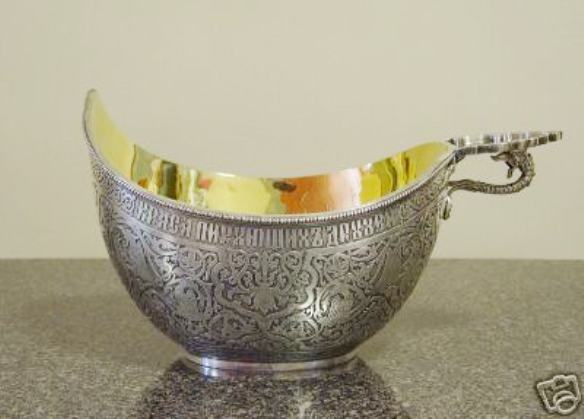
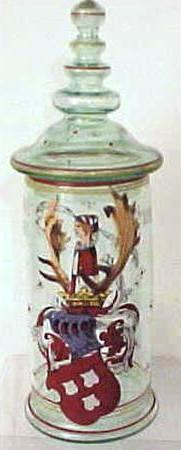
Coat of Arms – IN HERALDRY THIS IS NOT CALLED A CREST! The “Crest” is what sets on top of the helmet or crown, above the shield. Shown above ▲: A small ‘humpen’ with a painter’s coat of arms = three smaller white shields on the larger red shield. The “Crest” is the person in the cap on top of the crown that is surrounded by the two elk antlers. [FWTD]
CR- COBALT BLUE GLASS NICE THUMBLIFT BUT NEW
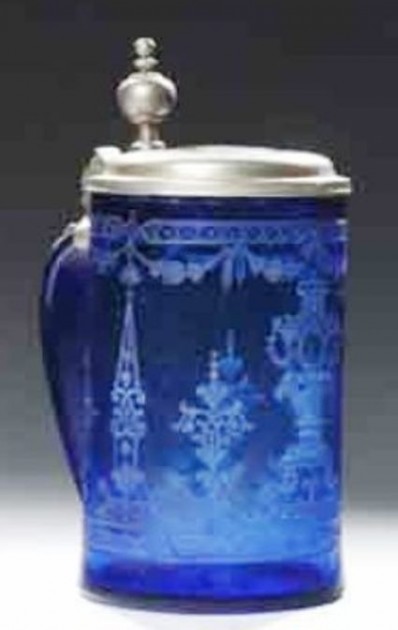
[a] Heavily carved coconut shell with Coat of Arms as main scene. Ca. mid to late 170o’s. [FWTD]
.
Coconut cups (vessels) – Drinking vessels, covered cups and pokals, all made from the various types of coconuts. Some are heavily carved, some pewter or silver mounted. All antique ones are highly collectable. Shown 2 above ▲ ▲: Carved with a family’s Coat of Arms.* Above ▲: A very unusual pewter mounted cup with a skull and cross bones on the lid and the Virgin Mary and Baby on the front medallion, with hanging crosses (but not crucifixes.) The jury is still “out’ on what all this means.
“CODE OF ARMS” = NOT!! as has been seen many times on eBay! It is “Coat of Arms (COA).” A term used in Heraldry that means the full pictorial achievement of a family or organization. It includes the shield, a helm or crown, and crest (that is the item that rests on the helm, or crown), and the mantling.
The use of the word “Crest” in lieu of Coat of Arms on a beer stein, even though one can find it used as such in a dictionary is a mistake! The German name for Coat of Arms is “Wappen.” Shown above ▲: “COA” for a painter, on an enameled beaker done in the Heckert style, but unsigned. The “Crest” ▲is the person in the red and white cap sitting on top of the crown.
Coin silver — By 1830 here in the USA: “COIN”, “PURE COIN”, “DOLLAR”, “STANDARD}, PREMIUM” or the letters C or D were used to indicate 900/1000 parts of silver. (Some lesser amounts such as .800 were also considered coin at prior times.)
CR- COIN SILVER MUG – Mid-19th Century Maine Coin Silver Mug by Fenno & Hale (Jeremiah & Charles) of Bangor, 1848-c. 1861, COIN = .800 TO .835
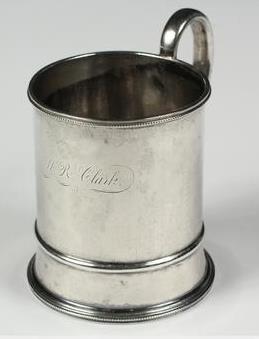
Coin steins (Muntzkrugen in German. ) – Any stein with applied (soldered) or mounted (into the body) coins or medallions. Usually found in silver. The trick is how to bend the coins without making them rip. Of course the dates on the coins are no indication of the real date.
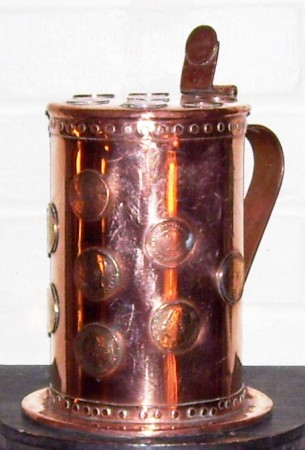
Shown above ▲: An English hand made stein with coins from the sailors travels. Circa 1880. Given the fabrication that looks like boiler work, I think he must have been a machinist. [FWTD]
Silver Norwegian [?] Peg Tankard, 1750. Lion thumbpiece with ball, . 830 Silver, 18 th Century Coins around the lid only.
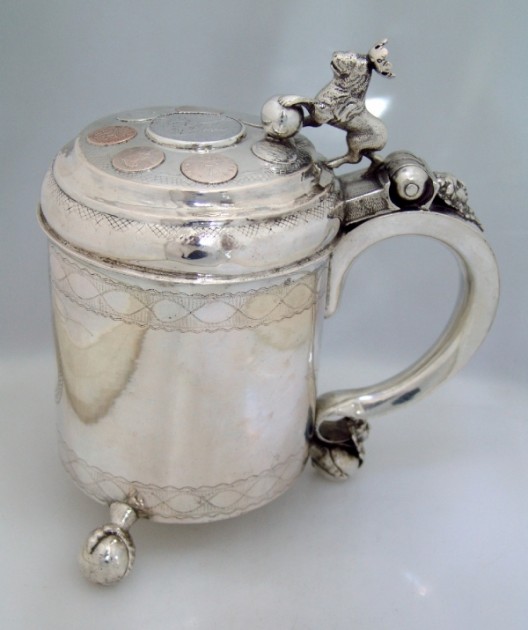
For more see the page: http://www.steveonsteins.com/coined-steins-munzhumpen-and-beakers-munzbecher
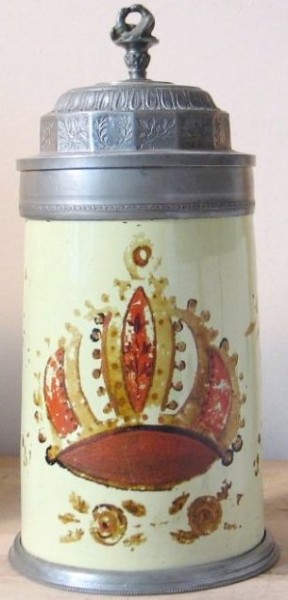
Cold painting — A non-durable method of stein decorating that does not require firing; uses varnishes or gold leaf. Wears easily as can be seen on creamware stein above. Below:Another example. I can not account for [figure out why] the paint lose just above the pewter base.
.
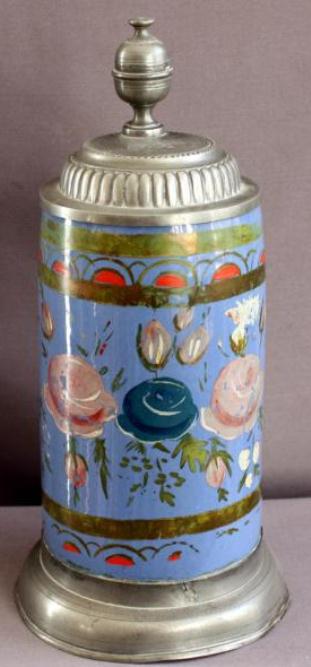
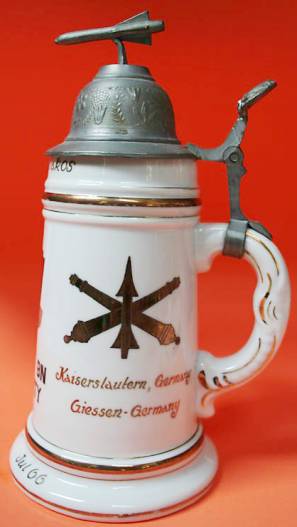
Cold war steins – USA , and other countries, military unit steins purchased by US troops in West Germany, starting about 1952 / 1953 and on into the re-uniting of Germany in July of 1990.
For a full article on these steins, see: http://www.steveonsteins.com/guest-writers-articles-5-us-military-steins-from-the-cold-war-era-by-norman-paratore
Cologne cathedral’ mugs and steins – There is a lot of confusion about these little mugs and beakers. V &B Mettlach made several versions of them as .5 liter beakers. Part of the profit supposedly was donated to the Cathedral’s building fund. Mr. xxx wrote a splendid article about the production of the original s it was published in Prosit many years ago. Because of the popularity of the V & B’s pieces other stein making companies, such as shown above by this Westerwald saltglazed mug, [FWTD] copied the design and sold them strictly for profit. The workmanship of the V & B pieces far exceeds the one blue grey stoneware example shown above. hopefully a photo will become available soon. in the meantime here is a close example of the colors and quality , also V & B Mettlach, same time frame.
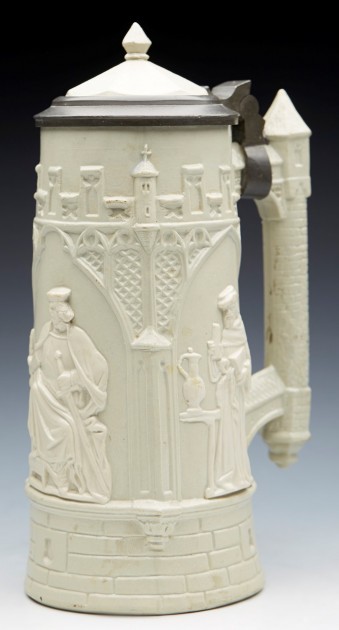
This design ▲ was also copied; shown 3 photos down, next to the copper Cologne display stein
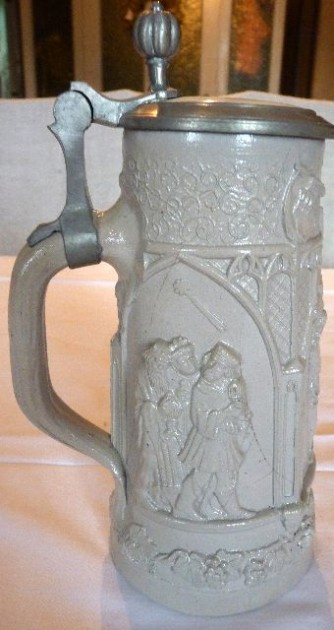
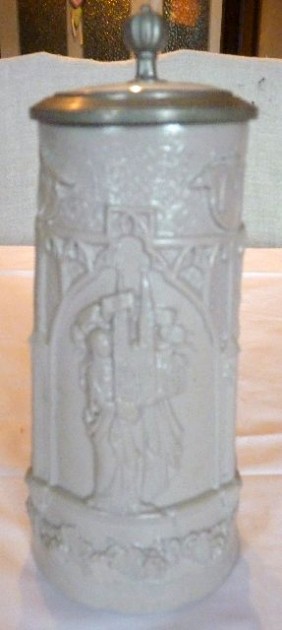
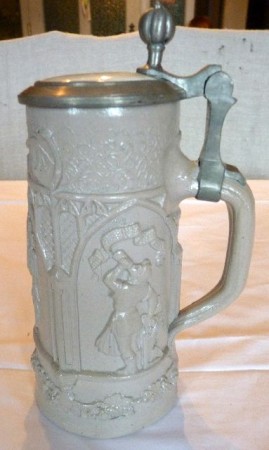
Another .5 liter copy, due to the handle design this one was probably made in Regensburg. Ca. 1870.
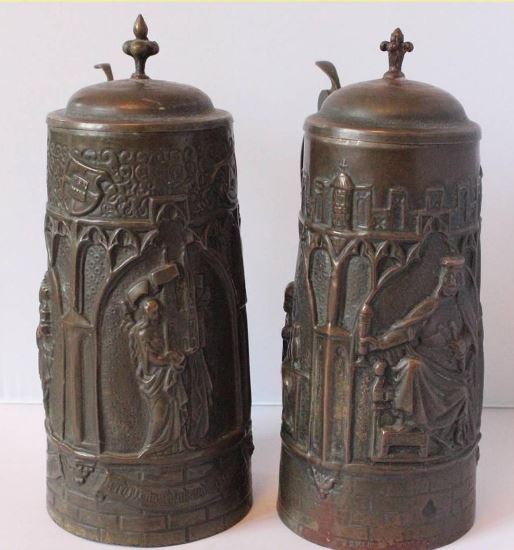
{L} Cologne beaker design on a stamper brass copy.These are “display steins.” See compendium for more.
Cologne / Koln, city of – Antique German city on the Rhine River, very famous for its stoneware steins in the early 1500’s .
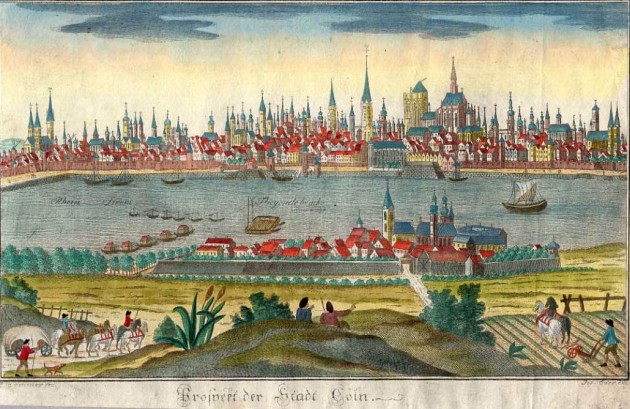
“KOLN” City map – 1600’s.
. .
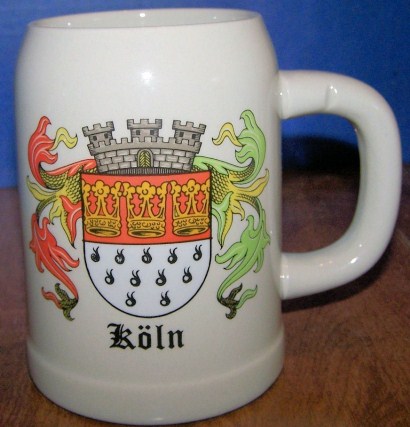
Shown above: A new .5 liter stoneware souvenir from the city with its Coat of Arms with “St. Ursala’s Tears” on the bottom half.
Shown below ▼: A very interesting (and scarce) pair of 1500’s Cologne stoneware steins. I think probably made around the Cologne area, but before the potters started to make Schnellen. It is unknown when the lids were added but close to contemporary with the body, if not so.
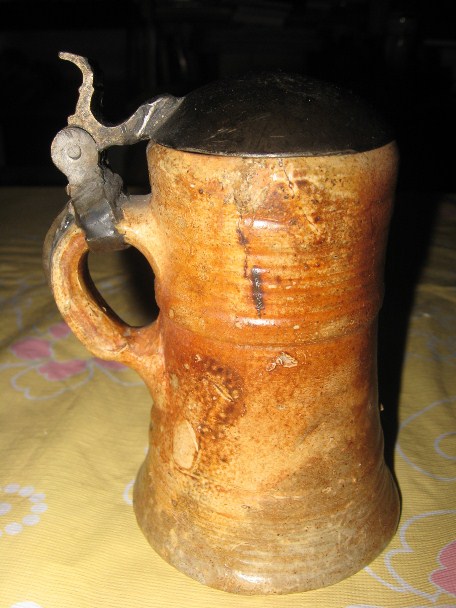
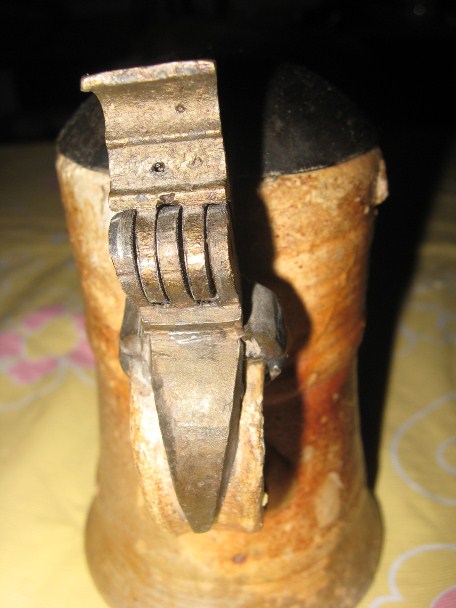
Below: a small drinking “mug” of the same vintage, shown for comparative purposes. Uneven heat in the primitive kilns back then causes this effect on the body colors.
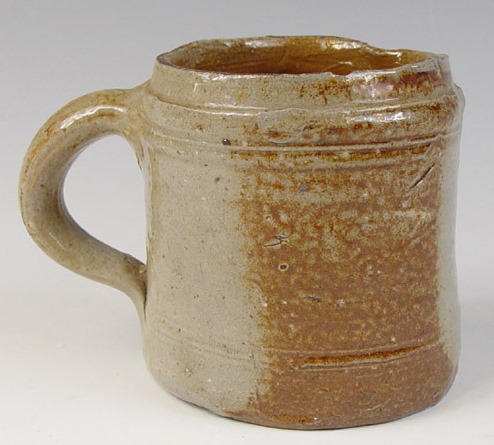
.
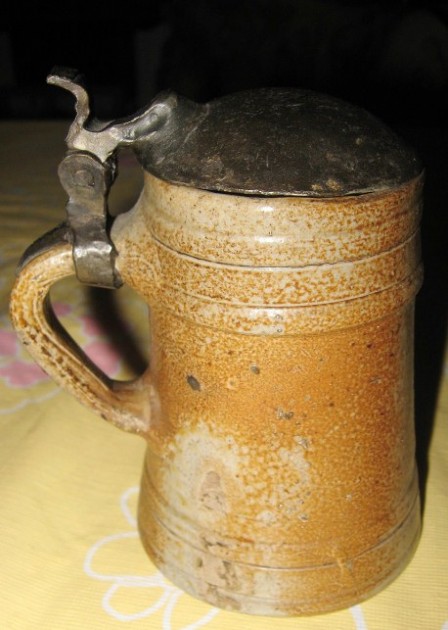
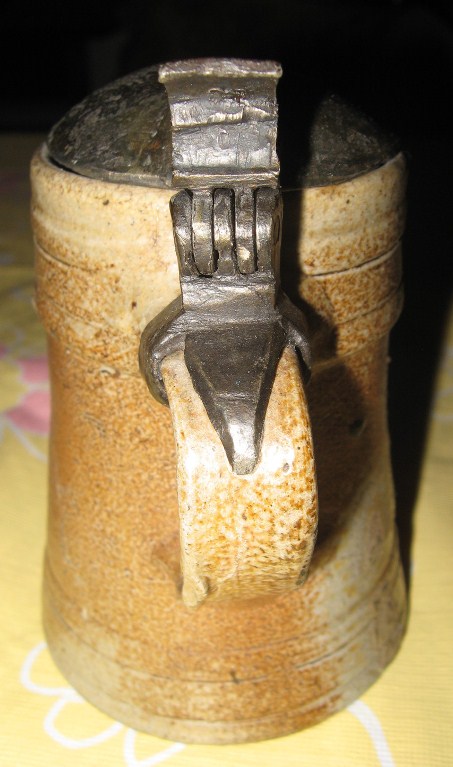
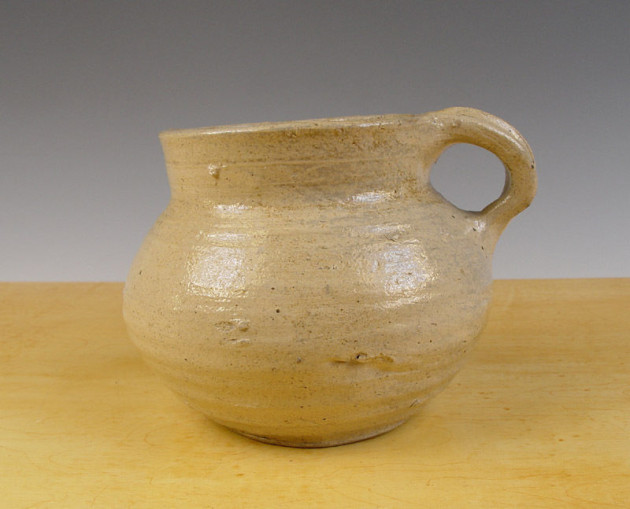
ABOVE ▲ NOT YOUR AVERGE MUG — German Koln Stoneware Chamber-Pot = ”Pispot” 16th C.

College steins (USA) – In the late 1800’s almost evey major USA college. Usually not collected as a sub set, but singularly, however, I know of one collector who bought nothing but V & B Mettlach steins made for Harvard. He had about 20 and all the same size! Shown above ▲: Pottery .5 liter, PUG, made for students at the M.I.T. =The Mass. Inst. of Technology. These are a far cry away from the present day college beer mugs found on the market, such as shown below. [SC]
.
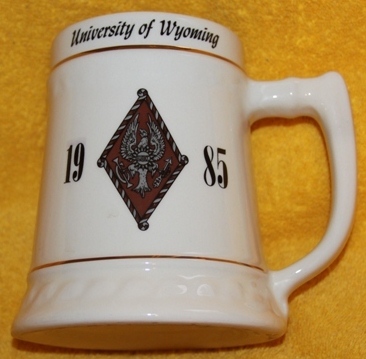
.
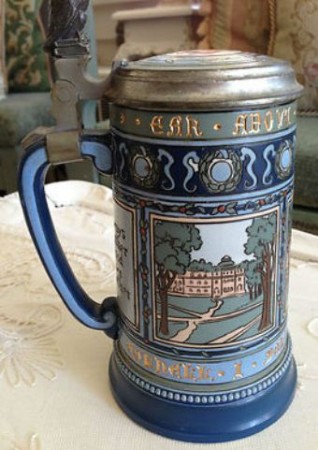
A much nicer, V & B Mettlach for Cornell University.
Columbian Art Pottery – BEER MUG Trenton N. J. [ANOTHER IN SERIES] Monk Mug
![CR- Columbian Art Pottery BEER MUG Trenton N. J. [ANOTHER IN SERIES] Monk Mug](http://www.steveonsteins.com/wp-content/uploads/2013/06/CR-Columbian-Art-Pottery-BEER-MUG-Trenton-N.-J.-ANOTHER-IN-SERIES-Monk-Mug.jpg)
Monk Drinking out of ITALIAN WINE BOTTLE Beer Mug [FWTD] ONE OF MANY FIRMS BUYING THESE DRINKING MONKS DECALS
![CR- Columbian Art Pottery Monk Drinking out of ITALIAN WINE BOTTLE Beer Mug [FWTD] ONE OF MMANY FIRMS BUYING THESE DRINKING MONKS DECALS](http://www.steveonsteins.com/wp-content/uploads/2013/06/CR-Columbian-Art-Pottery-Monk-Drinking-out-of-ITALIAN-WINE-BOTTLE-Beer-Mug-FWTD-ONE-OF-MMANY-FIRMS-BUYING-THESE-DRINKING-MONKS-DECALS.jpg)
Columbine cup – Elaborate German type of silver cup of complicated form made by candidates for admission to the goldsmith’s guilds in Nuremberg. This type is recorded in documents from 1513, but the earliest visual records are a sketch by Jamnitzer of 1545 and an engraving by Scotts c. 1550. Shown: An ‘elctro-type’ copy of an original Columbine cup. Be careful out there boys and girls, ‘they’ have had hundreds of years to copy this stuff, and they do a good job!
Combed body (stoneware) – Gray stoneware steins, made in the Westerwald and popular in the 1830 – 50’s. The only body decoration was the scratched body surface done by a wire comb. Some lines go vertical and some diagonal. The pewter lids and mounts are usually quite impressive which is why I like them. Shown above: Two versions with the comb lines going both ways. With very impressive pewter lids and thumblifts. [BOTH FWTD]
CR- combed-stoneware westerwald these called bavarian, why, ALL THE BARS USED THEM -434×450
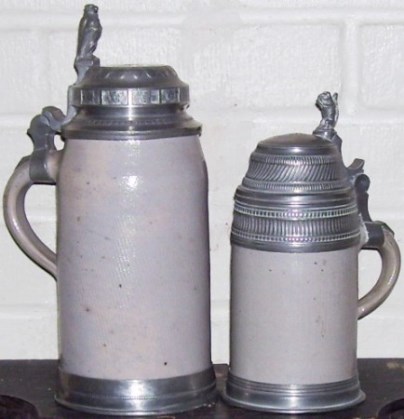
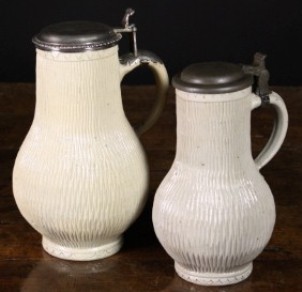
Shown ▲: The forefathers of the Westerwalders, combed bodies on Siegburg steins from the 1600’s.
Condition of beer steins – and effect on value. – This article has some good points for the beginning beer stein collector.
See: http://www.beerstein.net/articles/bsb-a.htm
“Come hither” steins / vessels – Beer steins, etc., made with a bell (or other noise maker) attached, used to summons the waitress for another beer.
CR- COME HITHER- A CHEAP VERSION Glass Beer Stein with Working Brass Bell 2IN on Handle Gold Trim 5.75 IN Heavy
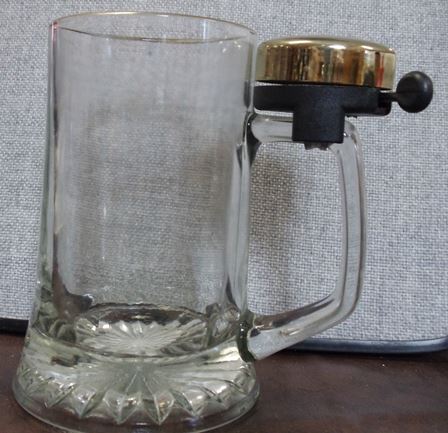
5 liter pottery stein with a push bell attached to the lid. Circa 1900.
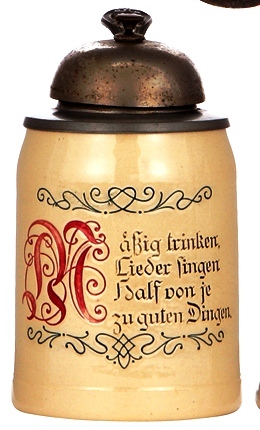
.
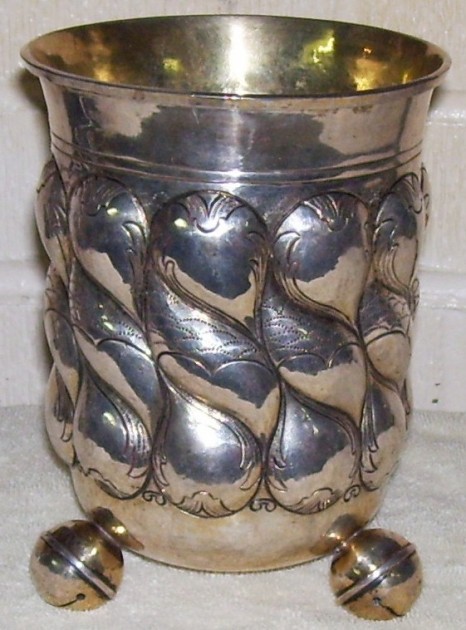
A large 6 ” tall [x] 4.5 “width. German, “Come Hither” lobed beaker. Made of .800 silver. No markings but Ca. 1800 I believe.
.
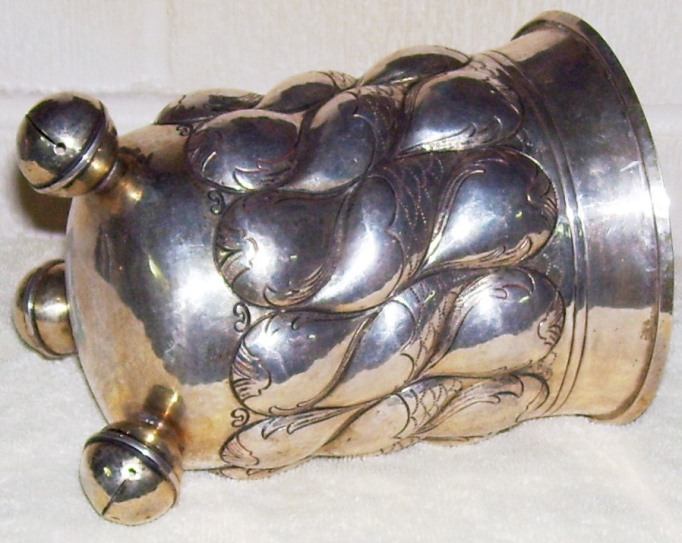
The “Come Hither” apparatus on this beaker is the three ball feet which are really bells. It makes a very pleasant sound. [FWTD]
.
This beaker was based I believe on much earlier silver set-on-lid beakers with lobed body designs such as shown below ▼
![SOS - COME HITHER BODY STYLE IN 1687. MUNICH MUSEUM [2]](http://www.steveonsteins.com/wp-content/uploads/2013/06/SOS-COME-HITHER-BODY-STYLE-IN-1687.-MUNICH-MUSEUM-2-500x630.jpg)
.
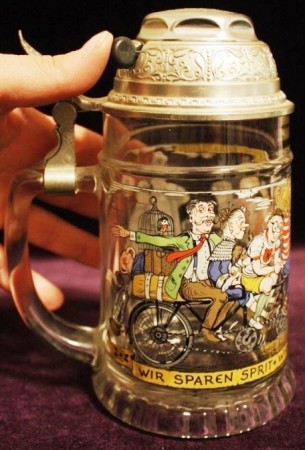
A very new example. Push the lever sideways to activate the sounds like a bicycle’s bell.
CR- cone LID Etched Mettlach 2580 German Beer Stein Signed Heinrich Schlitt 1899!
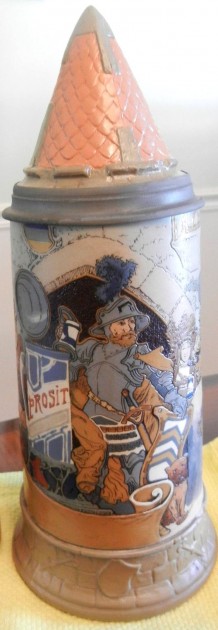
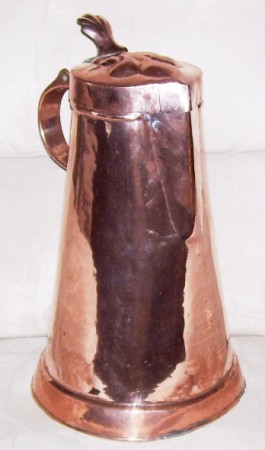
Copper — One of the true metals, mostly used in an alloy for drinking vessels, but also in Eastern European drinking vessels found lined with tin. Copper was rated right under silver as the preferred metal for old beer steins; many are found gilded. Shown: Late 1600’s Bohemian beer server. 16.5 inches tall. [FWTD]
See more examples at this web site’s Tab: “Copper Steins: Bohemian vs. Bavarian (Munich / Nuremberg.” (Nürnberg] ): http://www.steveonsteins.com/copper-stein-bohemian-vs-bavarian
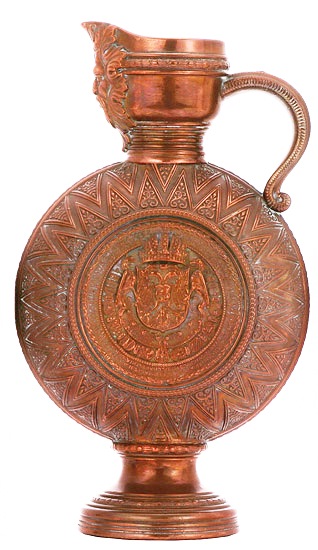
Copper clad – Steins / servers having a thick coat of copper applied to the pottery base by electrolysis. Shown: A 14.5 inch tall copper clad Westerwald jug, Circa 1900. For more info see page: “Copper clad”, aka: “Bronzed” beer steins. [New 9-12-11]
SEE: http://www.steveonsteins.com/copper-clad-beer-steins-draft
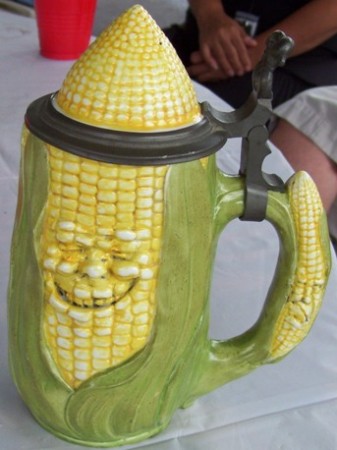
Corn, ear of (Character stein) – The V & B Mettlach one is very rare, as is the one shown. The Germans usually equated ‘Corn’ with pig food and therefore not for them. See: http://www.steveonsteins.com/kegels-and-pigs-the-predecessors-to-our-10-pins
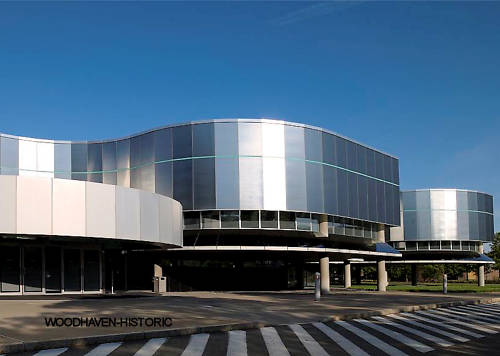
Corning Museum of Glass (CMG) – Located in Corning (city), in New York State.
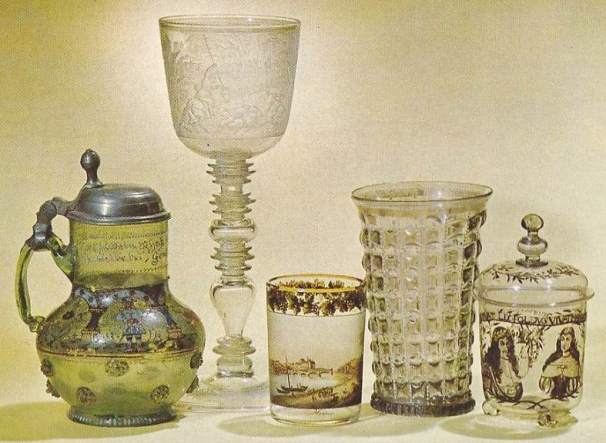
This institution besides having glass steins going back hundreds of years (as shown above ▲) was also bequeathed a very large collection of older German ceramic steins which they have on display. Worth a two day trip! One just can’t see and comprehend it all in one day and also expect to peruse the glass shop and book store.
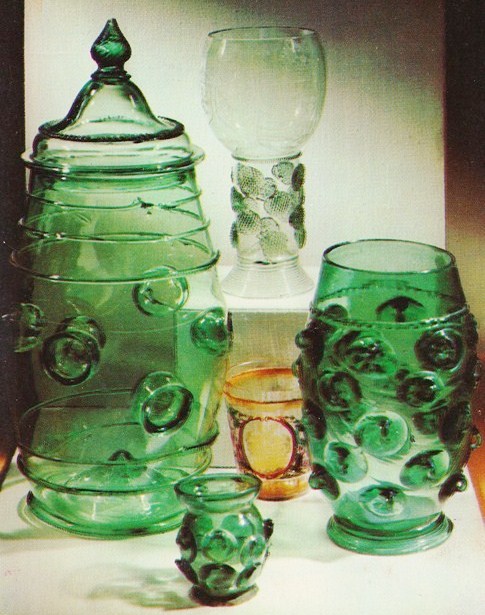
Just a small amount of their great early German “Waldglas”collection. “Daumenbecher ” [Thumb beakers] and Nuppen bechers [prunted beakers.]
CR- CORNISH COPPER ALE JUG – J & F POOL OF HAYLE
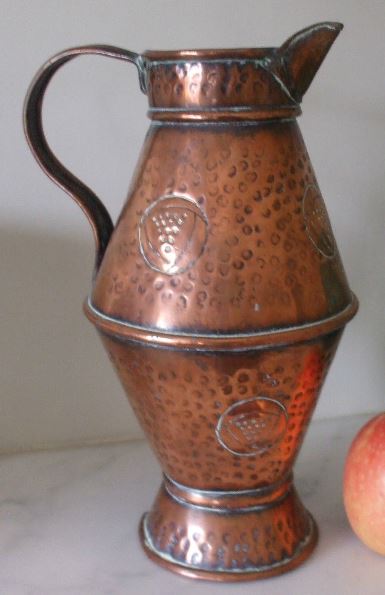
Covered “Flip” – A glass drinking vessel or beaker for drinking “flip”, a popular English /American drink in the 1700’s made with liquor or wine, sugar, and egg, topped with powdered nutmeg and served hot or cold.
Crack — An open break; contrast with “hairline.” Hairline is USA stein auctioneers most used description . I am often hard pressed to define the difference.! I guess with a “Hairline” it still leaks . but slower!
Please see “Hairline” for photos of the difference.
Also see “crazing” – this page below.
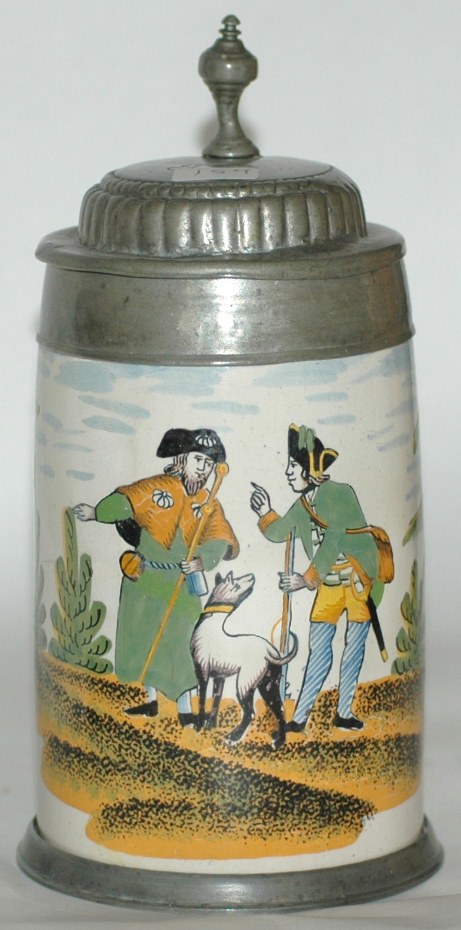
Crailsheim 1720-1827 (?) – City or town of major fayence stein production. For more info, see: http://www.thepatriotexchange.com/pss/hisfai.htm
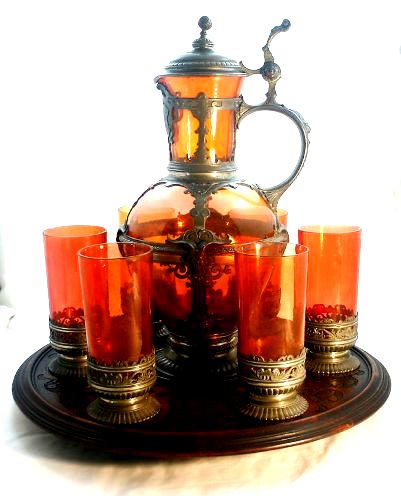
Cranberry glass – If one is not certain of what cranberry glass looks like you do now! Shown: A great cranberry glass and pewter beer drinking set made by J. Lichtinger, of Munich, Circa 1885.
See more of his great work on the L compendium page
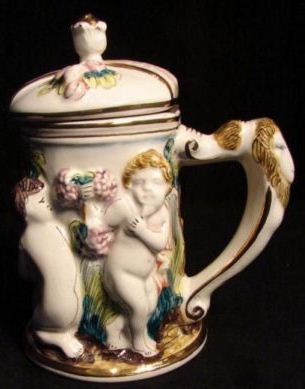
Crap-o-Di-Monte – A contemptible term applied to newer low end / VERY cheap porcelain [?] pieces that try to replicate the older style of steins made around 1880-1910. A takeoff on the term Capo-de-Monti which are really steins made in the Dresden area of Germany. These are POP steins. If you inherit one of these or you buy it in a box lot, please give it to your worst enemy for Christmas!
.
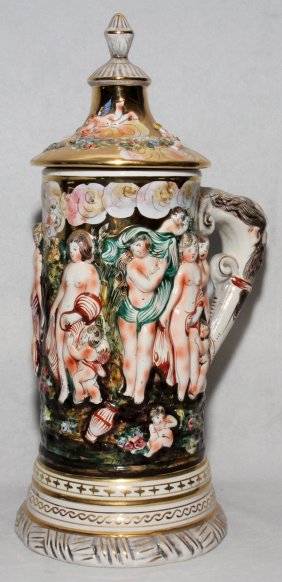
16 inches tall, new, and in my view only = another POP stein.
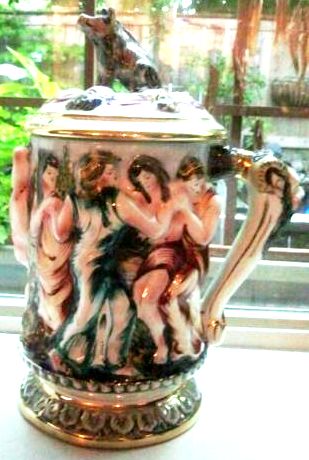
Just slightly better than the one above, with a little more detail.
On a scale of one to ten of “Crapos,” (ten being best), this one is about a three.
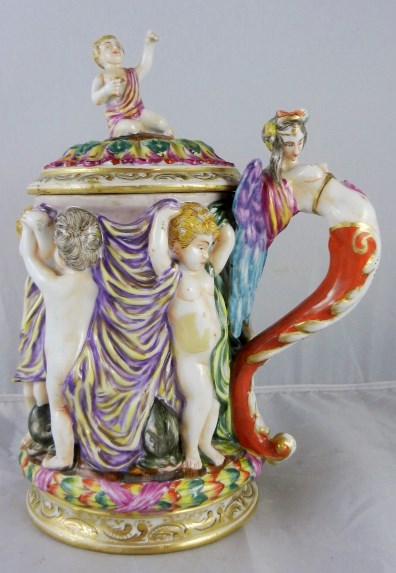
On a scale of one to ten of “Crapos” (ten being best), this one is about a five .
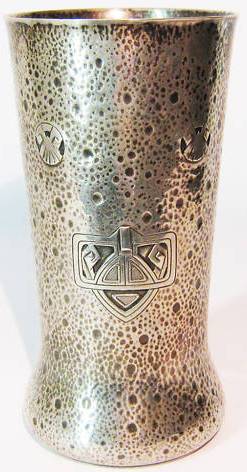
Crater design (cratered) – Heavy punch work, likened to the moon’s surface.
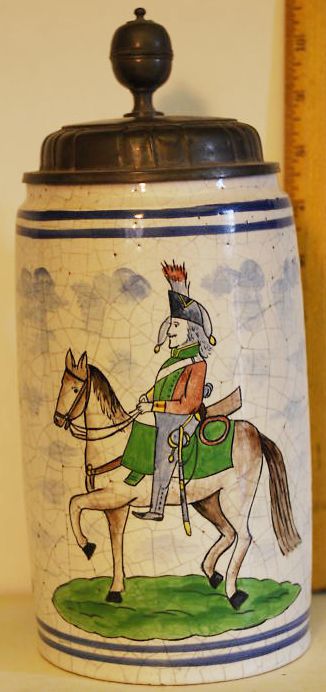
Crazing, faux = false / fake – Craze lines are very small irregular cracks is the glaze on Fayence and glazed pottery steins. See the example just below for comparison with the fake crazing on the newer Fayence stein above. Circa the late 1900’s.
.
Below: inside of the steins’ drum that darkness is just not this obvious with real crazing .
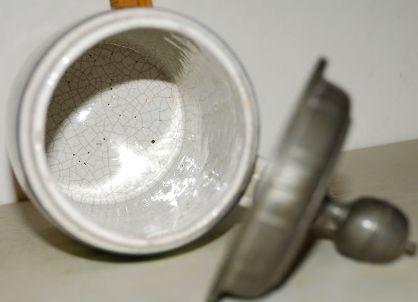
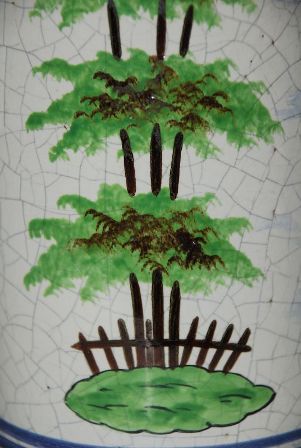
Detail of outside; it looks more like tortoise shell.
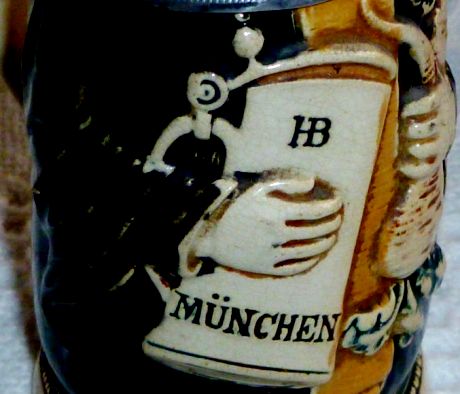
The crazing on this is original Circa 1890, Munich Maid. The stein is very small and hard to see. I had difficulty blowing it up to reproduce it here.
The fake ones are produced as part of the overall decor. This fools a lot of dealers, and new collectors. Real craze marks are not dark and there are usually not as many on real Fayence, and they are usually on the outside as part of the natural wear as a result of temperature changes over time.
Here are a couple more blown up so the lines are more visible:
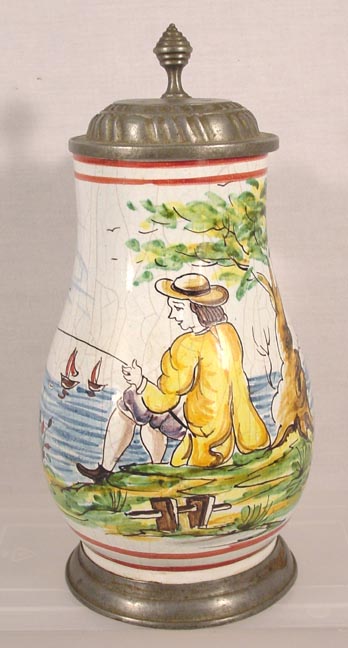
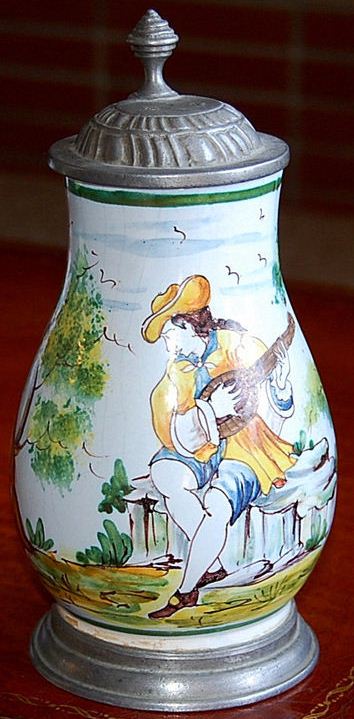
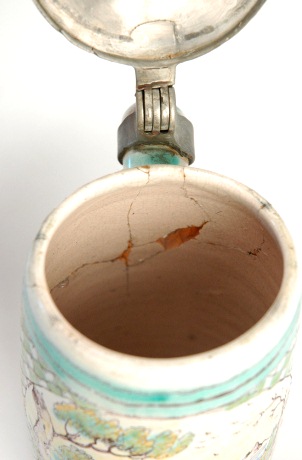
A little more than just crazing!
Shown top:An undecorated German creamware stein. Circa 1790. Shown right: A Cold painted Gwerman creamware stein, Circa 1840 – 50.
Creamware – An entirely different process than Fayence, however most stein collectors can not distinguish between the two on beer steins unless they place them side by side and can then see color variants. Originally started by Josiah Wedgwood in England in 1759.
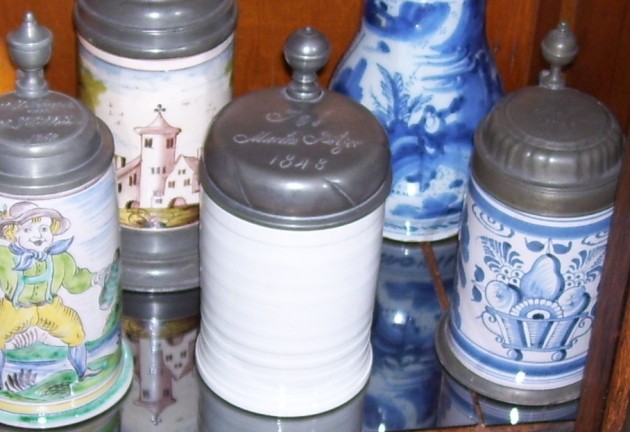
Shown center above . a Late 1700’s English cream ware tankard dated 1848 when a new pewter lid was placed on it in Scandinavia . Surrounded by fayence steins from Germany to show color variation . [FWTD]
![ESTONIAN ALPACA [L] RUSSIAN SILVER [R] BOTH WITH CRENULATED LIDS](http://www.steveonsteins.com/wp-content/uploads/2010/11/ESTONIAN-ALPACA-L-RUSSIAN-SILVER-R-BOTH-WITH-CRENULATED-LIDS-630x400.jpg)
Estonian alpaca [L], R ussian silver [R] Steins, both late 1800’S , Both with “Crenellated” lids. [BOTH FWTD]
Crenellated lids – also called “ripple lids” – Wood or metals mostly marked by heavily cut angles on squares or squares. Official dictionary definition :
- Having crenellations or battlements 2. Having a series of square indentations
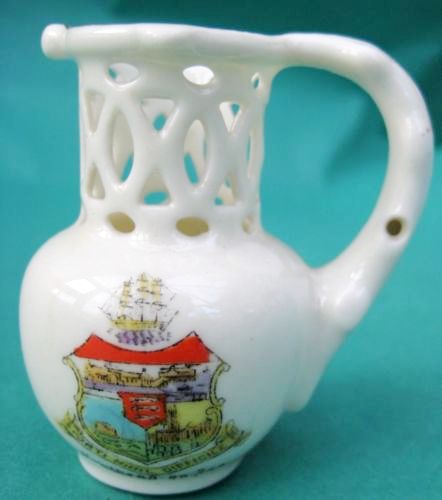
Crested China Vessels – An English collector’s misnomer to start with The vessels are sold all over the United Kingdom as souvenirs much like the refrigerator magnets in this country are but from towns that are visited in the UK. The difference is these are older, some are now scarce, and most always the miniatures are worth a few bucks. Many of them are miniature “puzzle jugs” as shown.
As stated, this term is also a misnomer for the same reason as “Crest” explained below ▼.
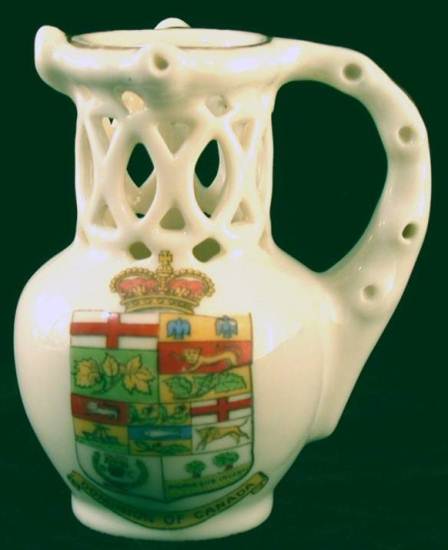
For more on “Puzzle Jugs and Mugs , please see: http://www.steveonsteins.com/in-the-near-future-2-1-2
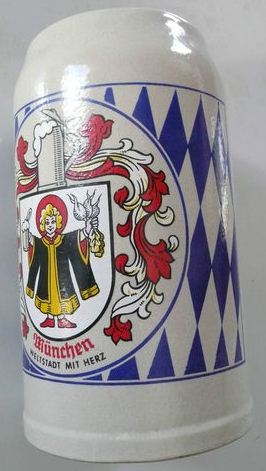
“Crest” (when it is not one) – The word “Crest” has now taken over the correct term of “Coat of Arms” used to denote the ensigna used by knights in the medieval period. When used in this context it is considered a”misnomer” and one which appears will never go away!
Shown above ▲: A modern day beer mug with a stylized, pseudo Coat of Arms where the foaming beer stein on the crown is its Crest!
Below ▼ is taken from the “Misnomer’s” page on this web site = (http://www.steveonsteins.com/beer-stein-dictionary-1):
Crest – A MISNOMER (One of the most misused words in stein collecting, next to: “stein.”) In heraldry and on beer steins that show such, it is the part of a “Coat of Arms” (SEE BELOW) that rests on top of the helmet, or crown!
It does NOT refer to the whole coat of arms , even if that is published on the SCI web site as being acceptable; it is not nto those that know! And the people who continue to use the word incorrectly are looked down upon by purists! Shown: The “crest” on the above “Coat of Arms” is the two multi-colored eagle wings, that sit on the top of the helm (helmet)!
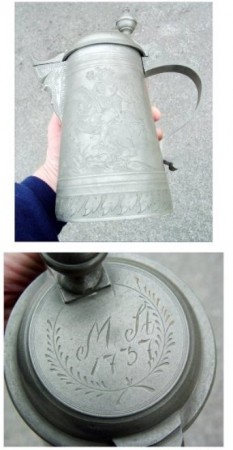
Crossed sevens – If seen on a stein (or anything else for that matter) it is an indication it was made about / after 1870, These are seen on many reproduction pewter steins and pewter plates / chargers. Shown: Two such examples: the pewter charger looks really authentic, but the crossed 7 (at 2:30 o’clock) gives it away!
For more of a discussion on these 7’s, please see: [Pewter Rules] = http://www.steveonsteins.com/pewter-rules-for-dummies
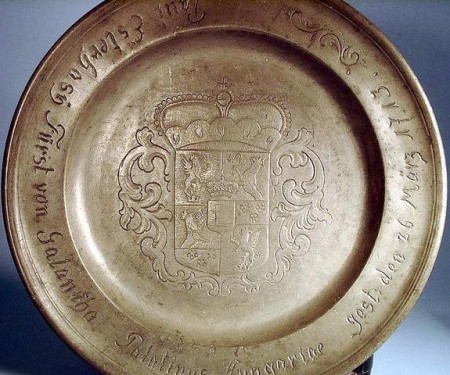
Cross-over steins – Beer steins that are collected by more than one collecting group, such as Reservist’s Steins appeal to general German military collectors, WW I collectors, gun collectors, and beer stein collectors. See “Bud Man” in this site’s Compendium for another popular cross over.

.
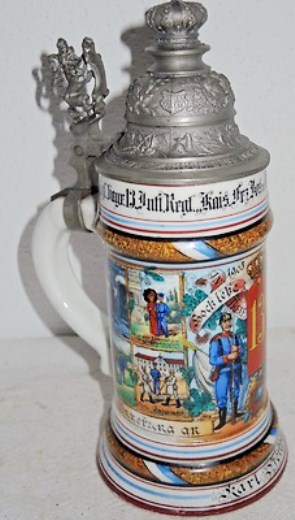
.
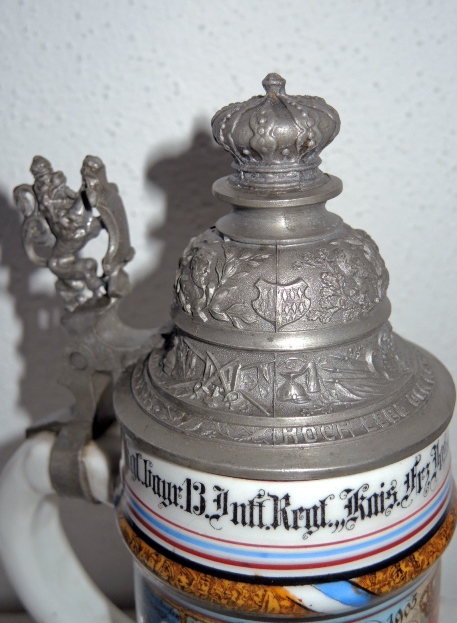
A different lid assembly than that just above, but also on a Bavarian stein.
.
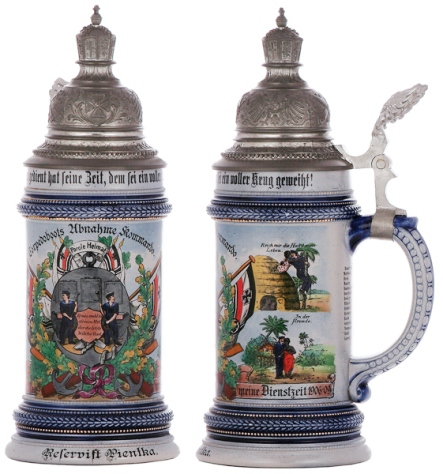
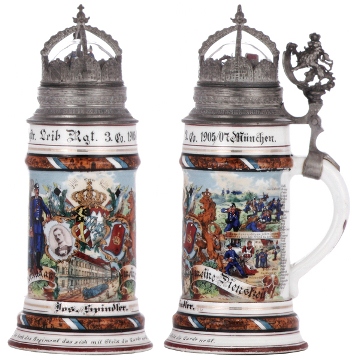
The most popular type of crown lid, as they come with military figures inside the glass dome.
Crown lid / Crowned lid – These can be found in several varieties as shown above, most always on a Reservist’s stein. Also see “Helmet lids.”
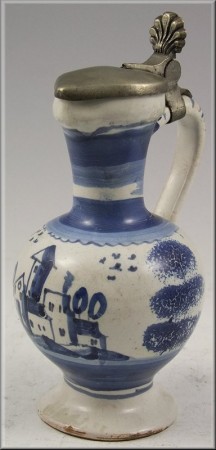
Cruet – A small server used at the dinner table for pouring small amounts of vinegar, oil, or wine. These were also used to freshen up wine glasses on the tables by the guests. Shown:A small fayence cruet from Hannover.[?] Annsbach [?] Circa 1820.
Below ▼: Swiss pewter cruet about 5 inches tall.
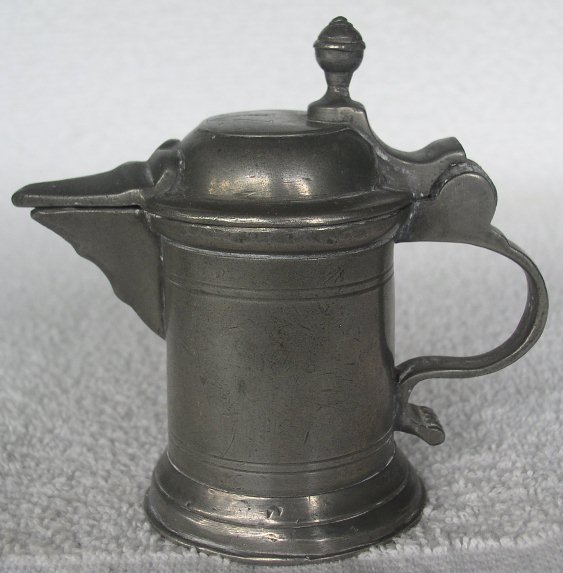
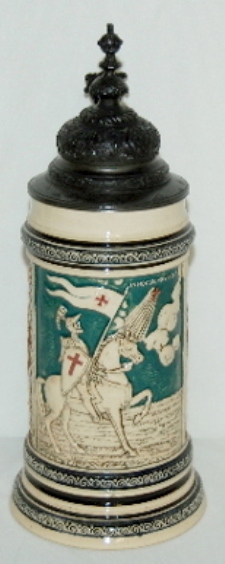
Crusader Stein – Shown: .5 liter pottery relief This is the only stein I have seen in 41 years of stein collecting that deals with the subject of the Crusades. It therefore is very rare but it still would not command much of a price.
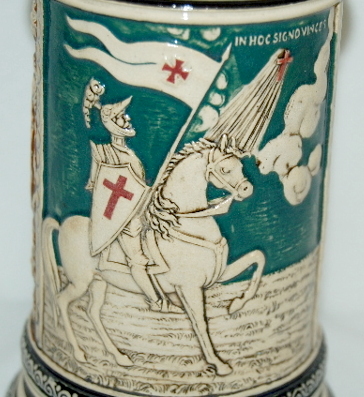
Detail above ▲. A glowing cross in the sky. Below ▼: A very interesting molded pewter finial also!
.
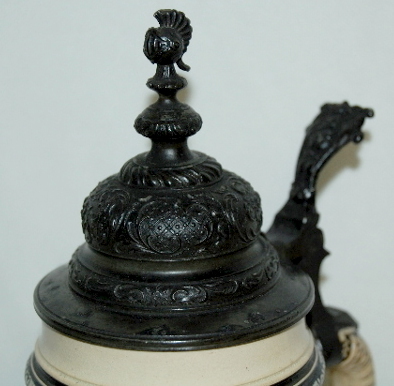
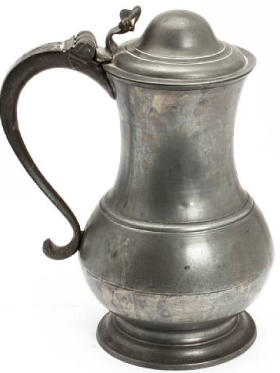
C – Scroll — Usually applied to the shape of a handle in the form of the letter C; also called “single scroll”.
For a (double) Double “C” Scroll, see below ▼[JB]. This is also called a “broken handle” by the Brits.
.
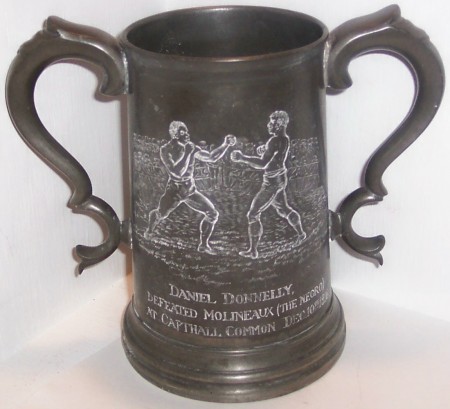
Cup and Cover: Pokal (German) = Cup and Cover (English ) – A very large drinking vessel of glass or metal mostly, that comes with a matching set-on-lid. Some smaller ones exist, but not many. Shown above:▲ While called a (small) pokal, it is Bohemian, Circa 1830, this is much closer to a “Cup and Cover,” English style appearance.
.
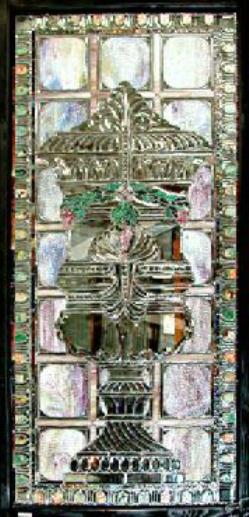
A cup and cover as shown in stained glass. Newer.
Cut card work — Flat sections of very thin silver, cut out to a simple pattern such as foliage, and soldered on to the surface of the object to be decorated. Brass cut card work is sometimes found on pewter steins in the 1700’s – early 1800’s .
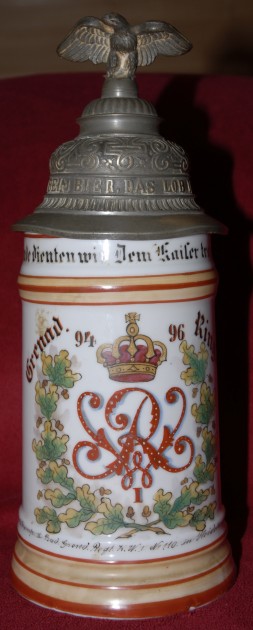
Cypher, Royal (German) – A cypher is a decorative design consisting of a set of interlaced initials. Shown:” The German Royal Cypher for Kaiser William I on a “Reservist’s” stein to the 110th Infantry Regiment.
[END – SP104 – 94- R5]
WISH TO CONTACT ME? STEVE (STEPHEN) =

“If you lend someone $20 and never see that person again, it was probably worth it.”

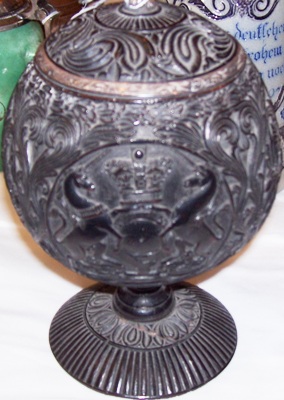
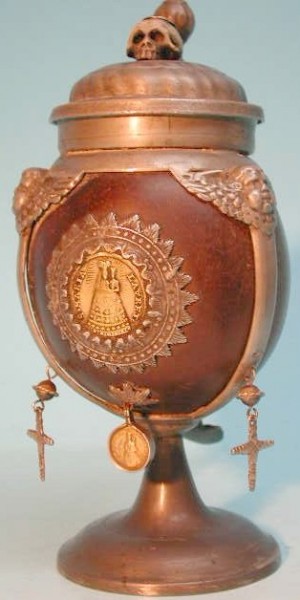
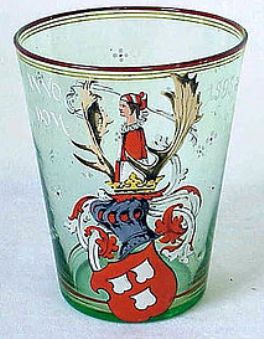
![1 - WEB - KOLN [BEAKER]](http://www.steveonsteins.com/wp-content/uploads/2010/07/1-WEB-KOLN-BEAKER.jpg)
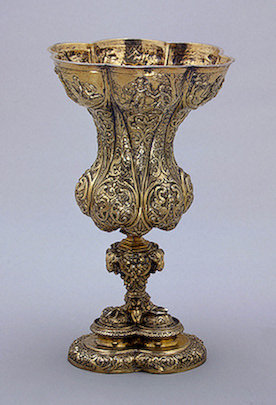
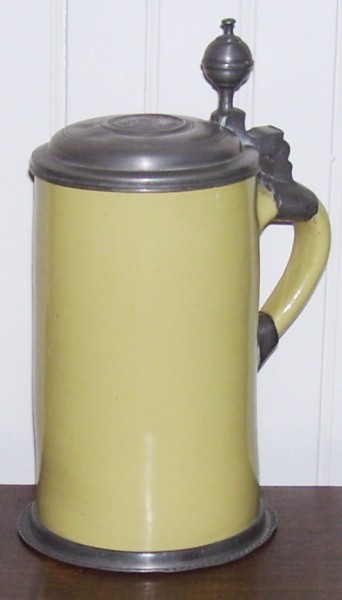
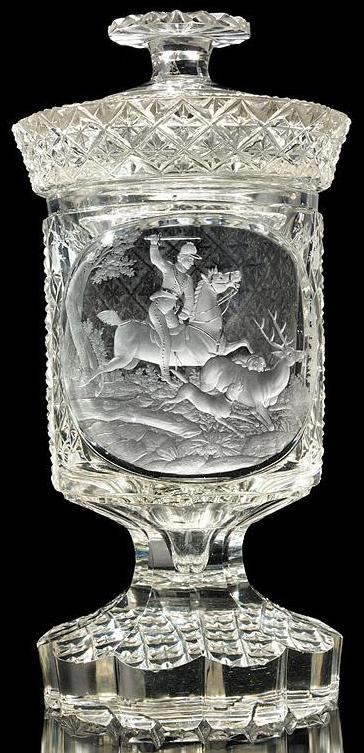
Leave a Reply